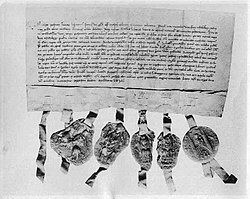Joint-stock company
A joint-stock company is a business owned by people called shareholders. Each shareholder owns company stock in proportion to the number of their shares (certificates of ownership).[1] Some shareholders may own a larger proportion of a company's share than others. Shareholders are able to transfer their shares to others without any effects on the continued existence of the company.[2]
Incorporation, a legal process, gives a company a legal personality separate from shareholders, and limited liability. This means the shareholders are only liable for the company's debts to the value of the money they invested in the company. So, joint-stock companies are commonly known as corporations or limited companies.
History
Finding the earliest joint-stock company is a matter of definition. Around 1250 in France at Toulouse, 96 shares of the Société des Moulins du Bazacle (Bazacle Milling Company) were traded at a value that depended on the profitability of the Society's mills. This was probably the first company of its kind in history.[3][4]
The much more famous, wealthy and powerful English (later British) East India Company was granted an English Royal Charter by Elizabeth I on 31 December 1600. The Royal Charter gave the newly created Honourable East India Company a 15-year monopoly on all trade in the East Indies.[5] The Company transformed from a commercial trading venture to one which ruled India.
In 1602, the Dutch East India Company issued shares that were made tradable on the Amsterdam Stock Exchange. This invention helped joint-stock companies to attract capital from investors as they could now easily trade their shares. In 1612 it became the first 'corporation' in intercontinental trade with 'locked in' capital and limited liability.
Closely held vs publicly traded corporations
The type of company most often referred to by the word "corporation" is a publicly traded corporation. In this type of company the shares are traded on a public stock exchange. For example, shares are traded on the New York Stock Exchange or Nasdaq in the United States. This is where shares of stock of corporations are bought and sold by and to the general public. Most of the largest businesses in the world are publicly traded corporations. However, the majority of corporations are said to be closely held, privately held or close corporations. This means that no ready market exists for the trading of shares. Many such corporations are owned and managed by a small group of businesspeople or companies. They can also be as vast as the largest public corporations.
Closely held corporations have some advantages over publicly traded corporations. A small, closely held company can often make decisions much more rapidly than a publicly traded company, because there will generally be fewer voting shareholders or the shareholders would have common interests. A publicly traded company is also at the mercy of the market. It can have capital flow in and out based on what the company is doing and also what the competitors are doing. Publicly traded companies also have advantages over their closely held counterparts. Publicly traded companies often have more working capital. They can also delegate debt throughout all shareholders. This means shareholders of publicly traded company will each take a much smaller hit to their returns as opposed to those involved with a closely held corporation. Publicly traded companies though suffer from this exact advantage. A closely held corporation can often stand a hit to profit with little or no long-term effect. A publicly traded company though often comes under extreme scrutiny if profit and growth are not evident to stock holders. If profits go down stock holders may sell, further damaging the company. Often this blow is enough to make a small public company fail.
Joint-stock CompanyClosely Held Vs Publicly Traded Corporations Media
One of the oldest known stock certificates, issued by the VOC chamber of Enkhuizen, dated 9 Sep 1606
The flag of the East India Company, which is speculated to have influenced the design of the Grand Union Flag
References
- ↑ Courtney, Thomas B. (2002). The law of private companies, 2nd ed. Butterworths. p. 26. ISBN 1-85475-265-0.
- ↑ "Joint Stock Company". West's Encyclopedia of American Law. Retrieved 4 May 2012.
- ↑ History of Paris stock exchanges
- ↑ "Shareholder lawsuit" (PDF). Archived from the original (PDF) on 2015-03-21. Retrieved 2015-09-14.
- ↑ Irwin, Douglas A. (1991). "Mercantilism as strategic trade policy: the Anglo-Dutch rivalry for the East India Trade". The Journal of Political Economy. The University of Chicago Press. 99 (6): 1296–1314. doi:10.1086/261801. JSTOR 2937731. S2CID 17937216. at 1299.



